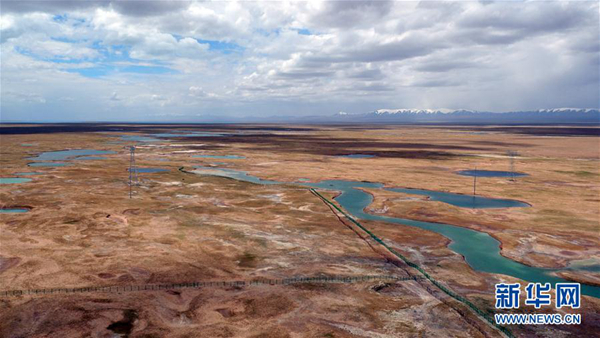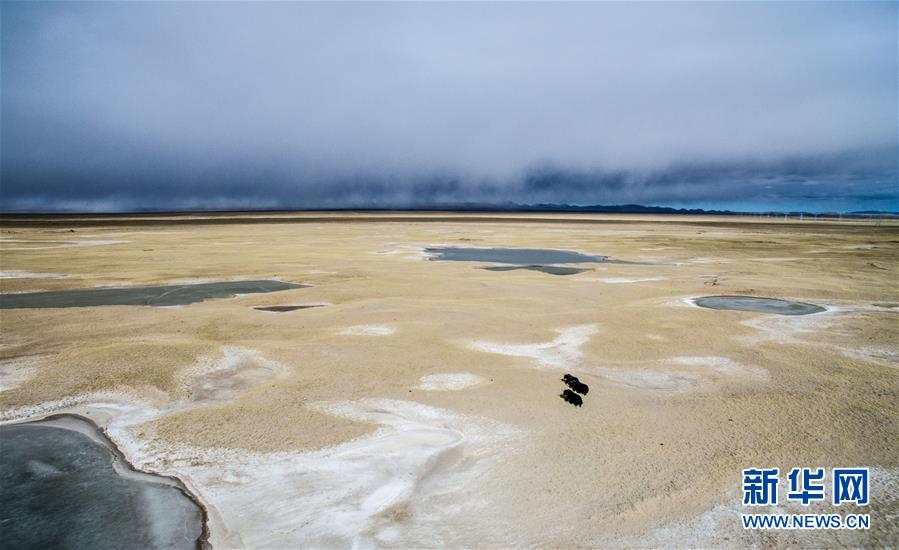Volunteers pick garbage, protect wildlife on World Heritage site Hoh Xil
Wen Cheng, a research scholar from the School of Life Sciences at Peking University, has visited Hoh Xil six times since May 2015.
As an expert participating in Hoh Xil's bid for UNESCO heritage status, Wen often heard foreign experts talk about the danger of Hoh Xil. "We almost died there," they often said.
Also known as Kekexili, Hoh Xil is a natural habitat, featuring breath-taking beauty and adverse weather conditions, located in the northwestern part of the Qinghai-Tibet Plateau. Roughly 45,000 square kilometers in size, it is home to around 230 wild animals, including 74 species of vertebrates like the endangered Tibetan antelope.
Famous for Tibetan antelopes and anti-poaching hero Sonam Dhargye, Hoh Xil was officially included in the UNESCO World Heritage list on July 7, making it the 12th natural heritage site in China to attain the status.
China's preparation for Hoh Xil's bid wasn't long, but it didn't affect the positive assessment by the International Union for Conservation of Nature (IUCN), the official advisory body on natural World Heritage, about the site's value. According to the IUCN's evaluation report, the nature reserve meets the criteria for its "superlative natural phenomena or natural beauty or aesthetic importance" and its "biodiversity and threatened species."
However, the successful bid for UNESCO heritage status doesn't mean Hoh Xil is free from ecological threats. The highway and railway that affect Tibetan antelopes' migrating routes, fencing, climate change and overgrazing are all threatening its biodiversity.
"In early 2017, after the Chinese government sent a letter to the IUCN and UNESCO promising that it will take measures to counter these threats, Hoh Xil was declared a World Heritage," Wen told the Southern Weekly.
But the status also brings bigger challenges for the volunteers and NGOs who have been active in the region for decades.
In a hero's footsteps
Almost everyone in Hoh Xil has heard the name Sonam Dhargye. The ranger and deputy Party secretary of the Zhidoi county, Qinghai's Yushu Tibetan Autonomous Prefecture, was killed in 1994 during a gunfight with poachers as he tried to protect endangered antelopes.
He was also mentioned in the IUCN report. "Sonam Dhargye, who was killed by poachers in 1994 while leading a patrol to protect antelopes, is recognized as a national hero," it reads.
Now, over 23 years later, poaching has been largely controlled. But many followers of the hero have continued his efforts to protect wildlife in the area.
Hanmei, 67, an ethnic Tibetan doctor, used to work as a medical director and specialist on high altitude sickness at Golmud People's Hospital. She is now providing medical services to volunteers in Hoh Xil.
"Jesung Sonam Dhargye and I are both from Suojia township, Zhidoi county, and we were classmates. After graduation, he returned to Zhidoi and I stayed in Golmud. The night before he visited Hoh Xil for the last time, he lived in my home at Golmud," she told the Southern Weekly.
Hanmei is not the only one who is driven by the spirit of Sonam Dhargye. In 1998, Yang Xin, who was travelling along the Yangtze River at the time, founded environmental NGO Green River. In 2011, by the bank of Tata River about four kilometers to the Hoh Xil Nature Reserve, Yang established the Yangtze River Source Water Eco-environment Protection Station.
Now, every day from 9:30 am to 6 pm, volunteers patrol the Bande lake located about 30 kilometers from the station and observe the activities of bar-headed geese and count their numbers.
Bar-headed geese are the highest-flying birds in the world with a population of only 70,000.
One of the volunteers is Siqiu Cairen, a local Tibetan who lives by the Tata River. As a key volunteer of Green River, he often leads teams of volunteers to the mountains, where they would camp and conduct field research. It's neither too risky, nor entirely safe - bears often appear in the mountain by the Bande Lake, and all the herders, including Cairen, are afraid of them.
With the continued efforts of volunteers like Cairen, from 2012 to 2016, the number of bar-headed geese in the region has risen from 1,178 to 2,700.
Increased human activity
The Qinghai-Tibet Highway and Railway, which crosses Hoh Xil, connect the nature reserve to the outside world.
However, according to the IUCN's assessment, the two roads, while bringing convenience to locals, are among the biggest threats to local wildlife. "The busy Qinghai-Tibet Highway severely affects the migration route of the Tibetan antelope from the Sanjiangyuan Nature Reserve to their calving grounds and back, as well as the movement of wildlife in general …," according to the report.
The report advises the nature reserve to block traffic for up to two hours per day during the migration period at passing points to let the animals cross the highway.
Fences, set up for husbandry and anti-desertification purposes, are also a notable threat as they disrupt the migration route of Tibetan antelopes, according to the report.
For volunteers like Cairen, however, what is most alarming is the increasing amount of garbage that has piled up in the area as a result of the increased human activity along the highway and railway.
On the afternoon of July 13, Cairen and his fellow volunteers collected 67 large storage bags of garbage within 100 meters on the Qinghai-Tibet Highway. The biggest bag was stuffed with over 200 food packages, cans and plastic beverage bottles.
Some of that garbage can be swept into Hoh Xil's grassland. Two years ago, a herder found that one of his goats had died after choking on a plastic package of a popular snack.
"The goat likes the smell of oil on the package. As it licked the package, it accidentally swallowed it. Most of these packages are thrown here by tourists and drivers of long-distance trucks," Yang said.
The garbage doesn't just come from the tourists; locals also contribute to it. Cairen recalls that when he was young, villagers would dispose of their garbage right outside their village. Goats would search for food in the piles of garbage as high as two meters and spread over a stretch of 1 kilometer.
Each year, during the annual horse racing, herders would gather together, light up fire and cook in the open, celebrating the occasion with strong-flavored snacks and food. After the race was over, the crowd would disperse, but iron, glass and plastic containers and utensils would be left behind in the plateau, attracting curious animals who passed by.
Cairen started to collect garbage as a volunteer when he was in primary school.
In 2001, Yang organized a volunteer garbage-picking team in Tanggula Mountains Central Primary School. As a member of the first batch of volunteers, Cairen and 12 fellow members, wearing badges and holding flags, started to pick up garbage initially in their school and then in the town. Grown-ups, afraid of being "taught" by the kids, often collected their garbage when they saw the team coming.
Over the years, the volunteer team expanded from young students to adults and even celebrities. The garbage collection program also upgraded into an exchange program in which people could swap waste materials for food: 10 plastic water bottles, for example, could be exchanged for a new bottle of water; 10 instant noodle containers for a box of instant noodles; and 10 used batteries for four new ones.
Rising temperature
The rising temperature also poses a threat to the ecology of Hoh Xil.
Tudan Danba, a local herder, said he feels that winters have become warmer in recent years. In the past, herders would start slaughtering cows and goats in October to prepare for the chilly winter. Now, the time for the slaughter has been pushed back to late November because if they slaughtered the animals earlier, the meat will go bad quickly.
According to IUCN's report, from 1961 to 2014, the annual average temperature change in Hoh Xil was 0.34 C per decade. The recorded average annual precipitation increased by 20.7 millimeters per decade, the Xinhua News Agency reported, quoting Qinghai Province meteorological data.
Wen, the Peking University researcher, is also shocked by the rapid climate change which has resulted in a change in geographical features. "The speed of change is rapid, with striking effects," he said.
From 2005, Green River, together with glacier experts from the Chinese Academy of Sciences, started to monitor and study the source of the Yangtze River.
By comparing and analyzing aerial shots and satellite pictures of different periods, they found that the largest melting range of the Gangjiaquba glacier, the biggest glacier at the source of the Yangtze River, expanded to over four kilometers from 1969 to 2007.
The melting of snow and the rise in precipitation have increased the water volume of the river body and turned some rangeland into lakes and wetland. While this has increased biodiversity in the region, Wen is also worried that this could affect the habitat of ungulates. "The habitats for Tibetan antelopes and yaks in the summer could shrink," he said.
But he also admits that these issues haven't yet been systematically studied. Following Hoh Xil's designation as a UNESCO World Heritage site, the effect of global climate change on the area's water environment will be studied through long-term monitoring.
Your Comment
Name E-mailRelated News
-
;
-
-

-
Hoh Xil: Wish she always retain her original appearance (III)
I’m sure many of us are familiar with the long distance that Tibetan antelope travel every year. Collectively, they make up wonderful scenery on this piece of free and unrestrained wilderness that is brimming with vitality.
-
-
-

-
Hoh Xil: Wish she always retain her original appearance (II)
Hoh Xil is a glamorous place that many people yearn for. For those of us engaging in protecting nature, becoming one of those having connections with this land carries more of a pilgrimage-like meaning.
-
-
-

-
Hoh Xil: Wish she always retain her original appearance (I)
Hoh Xil in Qinghai Province was approved to be included in the World Natural Heritage List at the 41st session of the UNESCO World Heritage Committee held in Krakow, Poland on July 7, becoming China’s 51st world heritage site.
-
Based in Lhasa, Tibet Vista is a Tibet travel agency that specialized in Tibet permit, and Tibet tours for both private and group travelers at a local price!
•4 Days Lhasa City Group Tour from USD 460 •8 Days Everest Base Camp Group Tour from USD 850 •15 Days Mt.Kailash Group Tour from USD 1780 •2016 Tibet Train Tours from Beijing, Shanghai, Chengdu, Xining,etc










